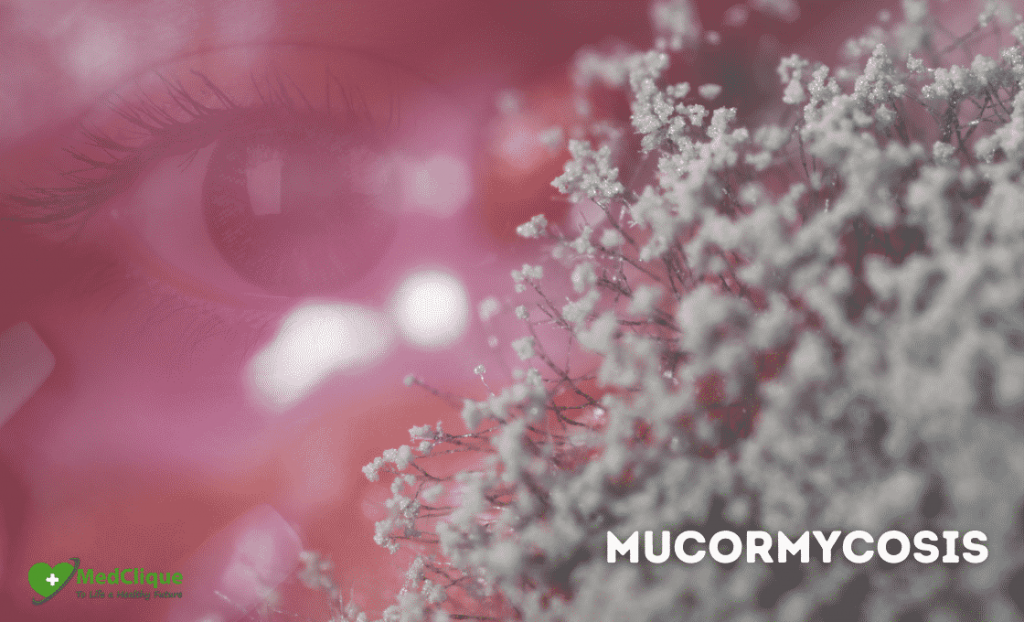Our country is witnessing multiple cases of Covid-associated Mucormycosis or Black fungus amongst patients, especially during or after recovery from the Corona infection.
Mucormycosis (previously called zygomycosis) is a severe but rare fungal infection caused by a group of molds called mucormycetes. These molds live throughout the environment.
It most commonly affects the sinuses or the lungs after inhaling fungal spores from the air. It can also occur on the skin after a cut, burn, or other types of skin injury.
Usually, there are two types of mucormycosis;
- Rhino-orbito-cerebral – The condition involves Nose, Eyes, and Brain.
- Pulmonary – The condition has Lung involvement.
Symptoms of Mucormycosis
The symptoms of mucormycosis depend on where in the body the fungus is growing.
Symptoms of Rhino-orbito-cerebral include:
- One-sided facial swelling
- Headache
- Nasal or sinus congestion
- Black lesions on nasal bridge or upper inside of mouth that quickly become more severe
- Fever
Symptoms of pulmonary (lung) mucormycosis include:
- Fever
- Cough
- Chest pain
- Shortness of breath
Few important Facts
- Mucormycetes, the group of fungi that cause mucormycosis, are present throughout the environment, particularly in soil and in association with decaying organic matter, such as leaves, compost piles, and animal dung.
- These fungi aren’t harmful to most people. However, for people who have weakened immune systems, breathing in mucormycete spores can cause an infection in the lungs or sinuses which can spread to other parts of the body.
- Mucormycosis is not contagious. However, spores can be spread in a moist environment.
- White fungus (aspergillosis) is another fungal disease that may affect the lungs.
- Candida fungal infections usually involve skin, which affects the lung, can cause Pulmonary Candidiasis.
Who is at more risk?
Mucormycosis is rare, but it’s more common among people who have health problems or take medicines that lower the body’s ability to fight germs and sickness.
People with diabetes and/or those who received steroids or immunosuppressant drugs or those having associated disease with compromised immunity are more prone to this opportunistic infection, which has high morbidity and mortality.
Certain groups of people are more likely to get mucormycosis, like:
- Diabetes, especially with diabetic ketoacidosis
- Cancer
- Organ transplant
- Stem cell transplant
- Low number of white blood cells
- Long-term corticosteroid use
- Injection drug use
- Too much iron in the body (iron overload or hemochromatosis)
- Skin injury due to surgery, burns, or wounds
- Prematurity and low birthweight (for neonatal gastrointestinal mucormycosis)
Diagnosis
If you have any of the above symptoms, you should consult your nearest ENT surgeon or dentist or a family physician immediately. The sooner you suspect, identify and diagnose it, then spread to the brain, eyes, etc., can be prevented.
The doctor will perform a clinical diagnosis by testing watery discharge or tissues from the affected area. They may consider your medical history, symptoms, physical examinations, and laboratory tests when diagnosing mucormycosis.
Healthcare providers who suspect that you have mucormycosis in your lungs or sinuses might collect a fluid sample from your respiratory system to send to a laboratory.
Sometimes, it needs to perform a tissue biopsy. A small sample of affected tissue is analyzed in a laboratory for evidence of mucormycosis under a microscope or in a fungal culture.
Imaging tests like MRI or CT-scan of Paranasal Sinuses/Brain to be conducted if needed. CT-Scan of Chest and pulmonary lavage are required in case of pulmonary mucormycosis.
Treatment
- The effective treatment is surgical debridement of the affected area.
- Injectable Liposomal Amphotericin B (L-AmB) is the drug of choice, but if it is unavailable, then consultants may use Amphotericin B deoxycholate (D-AmB) with due precautions of renal and other toxicity.
- Drugs like Posaconazole or Isavuconazole may also be used.
Do not start any prophylactic anti-fungal drugs if you have recovered from COVID-19 infection & have diabetes. There is no such recommendation from any medical authority (1).
How do I lower the risk of mucormycosis?
Below actions are primarily recommended, though they haven’t been proven to prevent mucormycosis. You should avoid,
- Areas with a lot of dust like construction or excavation sites.
- Contact with soil or dust.
- Direct exposure to water-damaged buildings and flood water after hurricanes and natural disasters.
- Activities that involve close contact with soil or dust, such as yard work or gardening.
Cover your body as much as possible. Wear shoes, long pants, and a long-sleeved shirt or gloves when doing outdoor activities.
Know these most effective remedies for Toenail fungus
Precautions for people with diabetes
- Effective glycemic control (Keep FPG-<130 mg/dl, PPG – <180 mg/dl, HbA1c – <7%)
- Consult your doctor immediately if any of the above symptoms are observed.
- Those on long-term Steroid therapy, can reduce the dose or stop it by consulting a treating doctor.
- While using steroids, keep your blood glucose under control and use insulin, if suggested by the treating clinician.
- Regular use of masks and social distancing to be followed.
The last lines…
Mucormycosis is a very rare disease and rarely affects a healthy individual. However, if it is left untreated, it might kill as many as 80% of the people who get it.
If you or anyone you know is recovering or has recently recovered from COVID-19, closely follow the signs and symptoms of mucormycosis.
Patients suffering from COVID-19 or those just recovering must practice impeccable personal hygiene to prevent mucormycosis.
